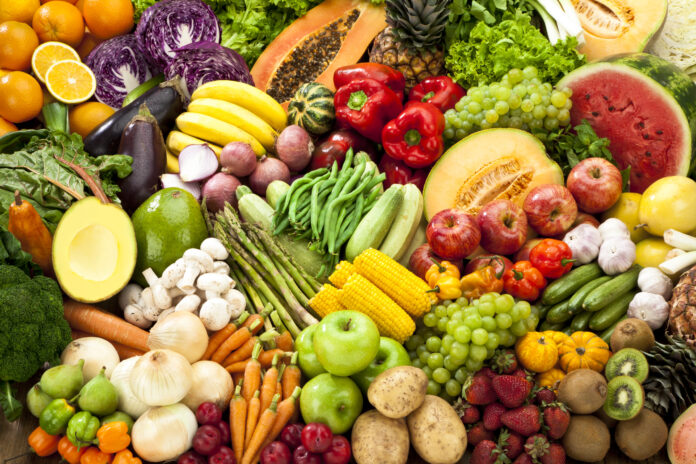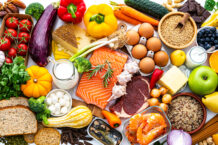Riddle: Thousands of these substances exist in fruits and vegetables and whole grains. They are neither vitamins nor minerals, and they supply no calories. Yet they may help protect against cancer, heart disease, and other diseases. What are they?
Answer: Phytochemicals, meaning “plant chemicals.” Like vitamins and minerals—which also come from plants (as well as from animal-derived foods)—phytochemicals are essential to good health. But no one knows how many and how much of them we need.
An amazing 4,000 phytochemicals have been identified so far, and many more remain to be discovered. Only about 150 have been intensively studied. One huge class of phytochemicals is the polyphenols, which include the much-discussed flavonoids. These come in many varieties, such as flavonols, flavones, flavanones, and isoflavonoids, to name a few. True to their name, flavonoids are sometimes flavorants, such as the allylic sulfides that give garlic, shallots, and onions their pungent taste and smell. Flavonoids can also be pigments, such as the anthocyanidins that make cherries and strawberries red, and blueberries blue. Another large phytochemical category is the carotenoids, which are also pigments, adding color to red peppers, pink grapefruit, tomatoes, carrots, and watermelon, among other foods.
Phytochemicals: Benefits for plants and for humans
Phytochemicals do big favors for plants—some protect plants from solar radiation, for instance, while others repel insects. They do big favors for humans, too, because they make foods attractive, tasty, and fragrant. Of course, if you dislike their flavor, they can keep you away from certain foods. Fortunately, the enormous range of tastes and smells means that wide choices are available. But not all phytochemicals are beneficial. Of the 4,000 known, some have effects in the human body, and some have no effect. Some are actually toxic (those in poisonous mushrooms, for example).
The other favor they do for us is to keep our cell chemistry stable in various ways. That is, they act as antioxidants: they dispose of cell-damaging free radicals, which are by-products of the processing of oxygen in the body. Free radical formation is boosted by various environmental factors such as smoking, air pollution, infection, and too much sunlight.
Phytochemicals help prevent cancer in a number of ways, some of them related to their antioxidant abilities. They can prevent potentially cancer-causing substances, or carcinogens, from forming. They may block the action of carcinogens on their target organs or tissue. Still others act on cells to suppress cancer development. They may also help protect against other diseases, notably heart disease. They may influence blood pressure and blood clotting or reduce the synthesis and absorption of cholesterol. Certain pigments (carotenoids) in plant foods may protect the eye against free radical damage and thus prevent or postpone macular degeneration, which can lead to blindness.
How to use this information
All plant foods contain phytochemicals, in varying amounts. The list below contains 15 categories of foods. This does not mean that any single food or any single category is going to work miracles. It does not mean that you should concentrate on any one category or food and forget the rest. Nor should you try to include all of them in a day’s diet. There isn’t enough room on this list to mention all good foods. But each group is well worth including in a healthy diet. If you follow our advice and base your diet on fruits and vegetables (a minimum of five servings a day) and grains (six to ten servings a day, preferably whole grains), you’ll get the phytochemicals you need. Include low-fat or nonfat dairy foods in this eating plan. Limit your meat intake and make lean choices.
Scientists are not sure which phytochemicals are responsible for the protective effects of this or that food. These substances almost surely act synergistically—that is, in conjunction with other phytochemicals—as well as with vitamins, minerals, fiber, hormones, and other compounds in foods.
Keep in mind, too, that some of the “possible benefits” listed below are more theoretical than others. A lot of the research has been done only in test tubes or with animals. Other theories about the benefits of some phytochemicals are based on food intake—not experiments with actual phytochemicals. For example, the study that showed a link between a high intake of tomatoes and a reduced risk of prostate cancer was a study of tomato consumption. Lycopene, plentiful in tomatoes, may be the protective element, but nobody knows for sure. This is nutrition on the cutting edge.
The moral of the story? While vitamin and mineral supplements make sense in some cases, phytochemical supplements do not. Eat lots of plant foods. Your best friend may turn out to be a Brussels sprout.
These phytochemical food groups are well worth including in a healthy diet
Food: Berries (blueberries, strawberries, raspberries, blackberries, currants, etc.)
Phytochemicals: Anthocyanidins, ellagic acid
Possible Benefits: Both act as antioxidants, thus as anti-cancer substances that may help protect cells. Ellagic acid has more than one anti-cancer activity. Anthocyanidins may also protect against heart disease. Berries are also rich in soluble fiber, which may help reduce cholesterol.
Food: Chili Peppers
Phytochemicals: Capsaicin, which gives peppers their heat
Possible Benefits: Little is known about potential health benefits; capsaicin may be an antioxidant or otherwise interfere with cancer development. May help prevent blood clotting. Chili peppers are also rich in vitamin C.
Food: Citrus Fruits (oranges, grapefruit, lemons, limes, etc.)
Phytochemicals: Flavanones such as hesperitin; coumarins; D-limonene (a monoterpene); carotenoids; flavonoids such as tangeretin and nobiletin
Possible Benefits: D-limonene, in citrus skin, can leach into the juice and may detoxify cancer promoters. Carotenoids may also fight cancer. Flavonoids act as antioxidants and may inhibit blood clotting. These fruits are also rich in vitamin C (a powerful antioxidant), other nutrients, and fiber.
Food: Cruciferous Vegetables (broccoli, broccoli sprouts, Brussels sprouts, kale, cabbage, cauliflower, etc.)
Phytochemicals: Indoles; isothiocyanates such as sulphoraphane; carotenoids such as beta carotene
Possible Benefits: Long classified as anti-cancer foods. Sulforaphane may neutralize cancer causing chemicals that damage cells; also interferes with tumor growth. Broccoli sprouts are particularly rich in the substances that convert into sulphoraphane. Indoles act to make estrogen less potent and thus may reduce the risk of breast cancer. These vegetables are also good sources of folic acid (a B vitamin), vitamin C, fiber, and carotenoids—all cancer fighters.
Food: Flax (seeds, flour)
Phytochemicals: Lignans
Possible Benefits: Lignans are converted to a form of estrogen in the body and are thought to have some protective effect against cancer. Lignans are not found in flaxseed oil.
Food: Garlic Family (garlic, onions, shallots, leeks, chives, scallions)
Phytochemicals: Allylic sulfides, other sulfur compounds, flavonoids such as quercetin
Possible Benefits: Adds flavor and zest to other good foods. May work against carcinogens and tumors in many ways, lowering risk of colon, stomach, and other cancers. May also benefit the heart. No certainty that cooked onions and garlic work as well as raw. Supplements are unproven and not recommended.
Food: Herbs and Spices (rosemary, sage, thyme, oregano, ginger, cumin, etc.)
Phytochemicals: Carnasol, phenols, curcumin, gingerols, terpenoids, etc.
Possible Benefits: Major benefit: adding flavor and zest to other good foods. May act as antioxidants and anti-cancer agents, even in small amounts.
Food: Legumes (lima, kidney, navy, and other beans, lentils, etc.)
Phytochemicals: Isoflavonoids, phytic acid, saponins, phytosterols
Possible Benefits: Anti-cancer activity; protection against heart disease. Phytosterols may protect against colon cancer. Beans contain folic acid (a B vitamin) and other nutrients, as well as soluble fiber, which may reduce blood cholesterol.
Food: Nuts (cashews, almonds, chestnuts, walnuts, etc.)
Phytochemicals: Ellagic acid, saponins
Possible Benefits: Potential benefits to the heart may come from these chemicals or from the beneficial fats (poly- and monunsaturated) in nuts. High in calories and fat, nuts should be consumed in moderation.
Food: Orange and Yellow Fruits and Vegetable; Leafy Greens (apricots, papaya, sweet potatoes, mangoes, carrots, spinach, corn, pumpkin, sweet peppers, etc.)
Phytochemicals: Carotenoids such as beta carotene, lutein, zeaxanthin
Possible Benefits: Many anticancer functions; strengthen the immune system; protect the retina from harmful radiation, thus reducing risk of macular degeneration. These fruits and vegetables are also rich in vitamin C, other vitamins, minerals, and fiber.
Food: Red Grapes, Red Wine
Phytochemicals: Flavonols such as quercetin; resveratrol, anthocyanidins, ellagic acid
Possible Benefits: Resveratrol may prevent damage to cells and curb tumor growth, reduce risk of skin cancer, and have beneficial effects on blood cholesterol. Quercetin may benefit the heart. Anthocyanidins and ellagic acid are antioxidants. Grapes, grape juice, and wine have different compounds and thus may have different effects.
Food: Soy (also a legume) (tofu, soy milk, soybeans, soy protein, etc.)
Phytochemicals: Isoflavonoids such as daidzein and genistein; lignans; saponins; phytosterols
Possible Benefits: Isoflavonoids and lignans are converted to a kind of estrogen in the body, and are thought to have some protective effect against cancer. Saponins and phytosterols also have anti-cancer activity. Different forms of soy have varying amounts of beneficial phytochemicals.
Food: Tea (green, black, oolong, but not herb tea)
Phytochemicals: Flavonols such as catechins and EGCG, plus other flavonoids
Possible Benefits: Tea, particularly green tea, may reduce the risk of many cancers, according to new research. Flavonols and other flavonoids in tea may combat cancer on several fronts. EGCG is a more powerful antioxidant than vitamin E; both neutralize cell-damaging free radicals. Catechins may protect arteries from plaque build-up. Some evidence suggests that flavonoids in tea may lower blood cholesterol.
Food: Tomatoes
Phytochemicals: Carotenoids, chiefly lycopene (also found, in much smaller amounts, in red peppers, pink grapefruit, guava, watermelon)
Possible Benefits:High intake, especially of cooked or processed tomatoes, may reduce risk of prostate and other cancers. Lycopene may fight cancer in several ways, including lowering potency of testosterone. Tomatoes also contain vitamin C and other nutrients.
Food: Whole Grains (whole wheat, oats, barley, rye, brown rice, etc.)
Phytochemicals: Saponins, terpenoids, phytic acid, ellagic acid, phytoestrogens
Possible Benefits: Saponins may neutralize cancer-causing substances in the intestine. Terpenoids and phytic acid may help reduce heart disease and cancer risk. Also rich in fiber, which helps lower blood cholesterol and may reduce colon cancer risk. Beneficial elements are concentrated in bran and germ; refined grains have little fiber and greatly reduced amounts of beneficial plant chemicals, even when enriched.




